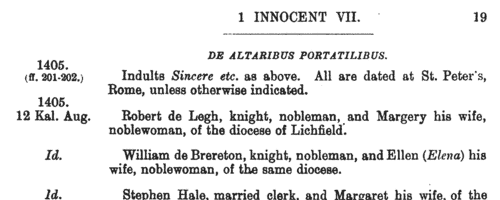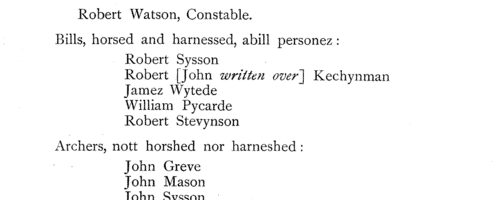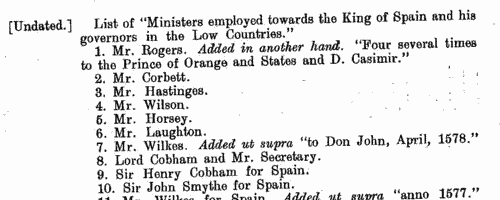Ferro Surname Ancestry ResultsOur indexes 1000-1999 include entries for the spelling 'ferro'. In the period you have requested, we have the following 13 records (displaying 1 to 10): Buy all | | | Get all 13 records to view, to save and print for £68.00 |
These sample scans are from the original record. You will get scans of the full pages or articles where the surname you searched for has been found. Your web browser may prevent the sample windows from opening; in this case please change your browser settings to allow pop-up windows from this site. Indults for Portable Altars: Diocese of London
(1404-1415)
Individuals (laymen, monks or priests) could obtain indults or indulgences from the Pope to possess portable altars, enabling them to do their devotions in unconsecrated places. The fee was 10 groats for one person, 12 for two (frequently a husband and wife). Lists of these indults, headed De Altaris Portatilibus, were entered in the Lateran Regesta in the Vatican archives; from the reigns of popes Innocent VII to John XXIII (1404 to 1415) there are such lists in volumes CXIX, CXXXI, CLIX to CLXI, CLXV, CLXVII and CLXXXIV, from the first year of Innocent VII, the second year of Gregory XII, and the second to fifth years of John XXIII. Those relating to the British Isles were copied and translated by J. A. Twemlow, and printed under the direction of the Master of the Rolls in 1904. The diocese of London included Middlesex, Essex and part of Hertfordshire.FERRO. Cost: £4.00.  | Sample scan, click to enlarge

| Rawdon Billmen
(1539)
In anticipation of war with France, Henry VIII ordered a general muster of able-bodied men throughout the kingdom. That for the wapentake of Skyrack, in the West Riding of Yorkshire, took place at Wike (near Leeds) before sir William Gascoigne the elder, sir William Middleton and sir William Maleverer, on 26 March 1539. Skyrack wapentake consisted of the ancient parishes of Aberford, Adel, Bardsey, Barwick in Elmet, Bingley, Collingham, Garforth, Guiseley, Harewood, (part of) Ilkley, Kippax, Otley, Swillington and Thorner, as well as the borough of Leeds. This muster roll listing the archers, billmen and spearmen of the wapentake by township or constablewick, was preserved among the State Papers in the Public Record Office; it was edited by W. Paley Baildon, and printed in three issues of the Miscellanea of the Thoresby Society (volumes 4 and 9) through to 1899. For each township there is a list of archers, divided into those fully and those partly ('parcel') armoured ('harnessed'), and a similar list of billmen; a few spearmen also appear. The weapon of the billmen - the bill or halberd - was a blade with a long wooden handle, sometimes with a hook with a cutting edge added at one side.
FERRO. Cost: £6.00.  | Sample scan, click to enlarge

| Ambassadors, ministers, soldiers and spies
(1586-1588)
The State Papers Foreign of queen Elizabeth consist mainly of letters and reports concerning England's relations with continental Europe. June 1586 to June 1588.FERRO. Cost: £6.00.  | Sample scan, click to enlarge

| Masters of Merchantmen
(1822)
The Society for the Registry of Shipping was instituted in 1760, and published an annual register and supplement. The annual register consisted of an alphabetical list of ships surveyed for insurance in Britain and Ireland, together with an alphabetical supplement. The society maintained a Registry Office at which alterations and additions were notified, and members delivering their registers when called for had them updated and returned on the following or the ensuing day. Each ship was given a number within each letter of the alphabet: ships' names were not unique, so within each name a ship was identified by the name of the captain or master at the time of the last survey. Then abbreviations indicate the type of vessel (Bg, brig; Bk, barque; Cr, cutter; Dr, dogger; G, galliott; H, hoy; K, ketch; S, ship; Sk, smack; Sp, sloop; Sr, schooner; St, schoot; Sw, snow), and whether sheathed (s) and/or doubled (d) with copper (C) and iron bolts (I B) or over boards (W & C), patent felt (P F), copper fastened (c f), copper bolted (c b), or copper repaired (C rp) sometimes with a date, such as (18)18. The third column, reserved for masters' names, is not particularly wide; with short surnames, an initial will be given; but longer surnames omit the initials, and even longer surnames are abbreviated. It will be borne in mind that these are the names of the masters not (necessarily) in 1822, but at the time of the last survey. Often new masters had been appointed by the time of re-survey, and their names are added in slightly smaller type under the original master's names in the third column. In the fourth column is the tonnage: where there is a blank under the number this indicates that the ship had two decks; more often the letters S D (B) for single deck (with beams); D W for deep waist; S D W single deck with deep waist; B D W single deck with beams and deep waist. Underneath the entry may run references to recent repairs: Cl. clincher built; Drp. damages repaired; grp. good repair; len. lengthened; lrp. large repair; N. (new) B. bottom, D. deck, Kl. keel, Sds. sides or UW. upper-works; rb. rebuilt; rsd. raised; Srprs. some repairs; or trp. thorough repair. In italics, the timber of the ship is described - B. B., black birch; C., cedar; H., hazel; Hk., hackmetack; J., juniper; L. O., live oak; M., mahogany; P., pine; P. P., pitch pine; S., spruce; W. H., witch hazel; W. O., white oak. The fifth column gives the place that the ship was built. For foreign ships this may be as vague as 'Dutch' or 'French'; but nothing in this record specifically indicates the nationality of ship, master or owners, except that an A. under the owner's name indicates that the vessel was American property. The sixth column gives the year of the ship's age; a few were still sailing after 30 or 40 years. The seventh column gives the owner's name, abbreviated in the same way as the master's name. Where the master was the owner, the word Capt. will appear. With vessels owned abroad, the name in this column is sometimes that of the port of origin, not the surname of the owner. Where there has been a change of owner by the time of re-survey, the new name is put underneath in smaller type. The printer sought to avoid confusion by aligning names of ports to the left and surnames to the right, but that leaves longer names doubtful. The eighth column gives the feet of the draught of water when loaded. The ninth column shows the destined voyage for which the survey took place, with the port of survey abbreviated (Be., Belfast; Br., Bristol; Co., Cork; Cs, Cowes; Da., Dartmouth; Du., Dublin; Eh, Exmouth; Ex., Exeter; Fa., Falmouth; Gr., Greenock; Hl, Hull; Hn, Harrington; La., Lancaster; Lh, Leith; Li., Liverpool; Lo., London; Ly., Lynn; Mt., Maryport; Po., Poole; Ph, Portsmouth; Pl., Plymouth; Sc., Star-Cross; Tn., Teignmouth; Tp., Topsham; Wa., Waterford; Wn, Whitehaven; Wo., Workington; Ya., Yarmouth), and the letter C where the vessel was a constant trader between the two ports. The tenth column gives the classification of the vessel (A, first; E, second) and its stores (1, first; 2, second) and the year of survey, e. g. 09 for 1809, or, if surveyed during 1821, the month, e. g. 3 for March. Where the vessel has been re-surveyed, the classification letter and number will be repeated or revised in the final column. The sample scan is from the main list. This is the index to masters in the main list and the supplement.FERRO. Cost: £6.00.  | Sample scan, click to enlarge

| Owners of Merchantmen
(1822)
The Society for the Registry of Shipping was instituted in 1760, and published an annual register and supplement. The annual register consisted of an alphabetical list of ships surveyed for insurance in Britain and Ireland, together with an alphabetical supplement. The society maintained a Registry Office at which alterations and additions were notified, and members delivering their registers when called for had them updated and returned on the following or the ensuing day. Each ship was given a number within each letter of the alphabet: ships' names were not unique, so within each name a ship was identified by the name of the captain or master at the time of the last survey. Then abbreviations indicate the type of vessel (Bg, brig; Bk, barque; Cr, cutter; Dr, dogger; G, galliott; H, hoy; K, ketch; S, ship; Sk, smack; Sp, sloop; Sr, schooner; St, schoot; Sw, snow), and whether sheathed (s) and/or doubled (d) with copper (C) and iron bolts (I B) or over boards (W & C), patent felt (P F), copper fastened (c f), copper bolted (c b), or copper repaired (C rp) sometimes with a date, such as (18)18. The third column, reserved for masters' names, is not particularly wide; with short surnames, an initial will be given; but longer surnames omit the initials, and even longer surnames are abbreviated. It will be borne in mind that these are the names of the masters not (necessarily) in 1822, but at the time of the last survey. Often new masters had been appointed by the time of re-survey, and their names are added in slightly smaller type under the original master's names in the third column. In the fourth column is the tonnage: where there is a blank under the number this indicates that the ship had two decks; more often the letters S D (B) for single deck (with beams); D W for deep waist; S D W single deck with deep waist; B D W single deck with beams and deep waist. Underneath the entry may run references to recent repairs: Cl. clincher built; Drp. damages repaired; grp. good repair; len. lengthened; lrp. large repair; N. (new) B. bottom, D. deck, Kl. keel, Sds. sides or UW. upper-works; rb. rebuilt; rsd. raised; Srprs. some repairs; or trp. thorough repair. In italics, the timber of the ship is described - B. B., black birch; C., cedar; H., hazel; Hk., hackmetack; J., juniper; L. O., live oak; M., mahogany; P., pine; P. P., pitch pine; S., spruce; W. H., witch hazel; W. O., white oak. The fifth column gives the place that the ship was built. For foreign ships this may be as vague as 'Dutch' or 'French'; but nothing in this record specifically indicates the nationality of ship, master or owners, except that an A. under the owner's name indicates that the vessel was American property. The sixth column gives the year of the ship's age; a few were still sailing after 30 or 40 years. The seventh column gives the owner's name, abbreviated in the same way as the master's name. Where the master was the owner, the word Capt. will appear. With vessels owned abroad, the name in this column is sometimes that of the port of origin, not the surname of the owner. Where there has been a change of owner by the time of re-survey, the new name is put underneath in smaller type. The printer sought to avoid confusion by aligning names of ports to the left and surnames to the right, but that leaves longer names doubtful. The eighth column gives the feet of the draught of water when loaded. The ninth column shows the destined voyage for which the survey took place, with the port of survey abbreviated (Be., Belfast; Br., Bristol; Co., Cork; Cs, Cowes; Da., Dartmouth; Du., Dublin; Eh, Exmouth; Ex., Exeter; Fa., Falmouth; Gr., Greenock; Hl, Hull; Hn, Harrington; La., Lancaster; Lh, Leith; Li., Liverpool; Lo., London; Ly., Lynn; Mt., Maryport; Po., Poole; Ph, Portsmouth; Pl., Plymouth; Sc., Star-Cross; Tn., Teignmouth; Tp., Topsham; Wa., Waterford; Wn, Whitehaven; Wo., Workington; Ya., Yarmouth), and the letter C where the vessel was a constant trader between the two ports. The tenth column gives the classification of the vessel (A, first; E, second) and its stores (1, first; 2, second) and the year of survey, e. g. 09 for 1809, or, if surveyed during 1821, the month, e. g. 3 for March. Where the vessel has been re-surveyed, the classification letter and number will be repeated or revised in the final column. The sample scan is from the main list. This is the index to owners in the main list and the supplement.FERRO. Cost: £6.00.  | Sample scan, click to enlarge

| Patentees of New Inventions
(1857)
Abstracts of British patents for new inventions applied for and granted from 1 January to 31 December 1857: giving date, name and address, and short description of the invention. It is then stated whether 'Letters patent sealed' or 'Provisional protection only'.FERRO. Cost: £6.00.  | Sample scan, click to enlarge

| Debtors, Insolvents and Bankrupts
(1881)
Bills of sale (binding assets to a creditor/lender), insolvencies and bankruptcies in England and Wales, October to December 1881FERRO. Cost: £6.00.  | Sample scan, click to enlarge

| Unclaimed Naval Prize Money
(1855-1902)
Various prize moneys were awarded to officers and men who served on board her Majesty's ships. For one reason or another a substantial number of these prizes, from as little as a shilling or two to as much as many pounds, remained undistributed by 1902, when this comprehensive list of the unclaimed moneys was printed: it lists unclaimed shares of prize money, slave and pirate bounties, salvage awards, parliamentary grants, gratuities and other moneys distributed by the Admiralty 1855 to 1902, but which omits moneys for service on the China Station during the war of 1856 to 1880, and special gratuities for service in Egypt (1882), Soudan (1884) and Soudan and Nile Expedition (1884-1885), for which there are separate indexes. In each case the sailor's name is given first (surname, then christian name or initials); rank or rating; ship in which serving at time of capture or award; and the amount due.FERRO. Cost: £6.00.  | Sample scan, click to enlarge

| Officers of the British Army and of the Indian Army
(1934)
The Half-Yearly Army List, issued By Authority, 30 June 1934, lists all officers in active service at that date, and this list was evidence of the status and rank of the officers contained in it. The entries are set out as a gradation list, by rank, from field-marshals to lieutenants, and within each rank in order of seniority at that rank. Each officer's name (surname first, in capitals, then christian name and present rank (with date of achieving that rank) and regiment &c. are given, for convenience, in bold type, with any national decorations in italics after the name. Each entry also gives date of birth, number of days service in the ranks, dates of service in each rank of officer, particular offices and postings (with dates) and, where appropriate, a summary of war service, and medals. For all but the oldest of the officers then serving, the war service details are for the Great War (1914-1921), and campaigns in Iraq, Waziristan, and the North West Frontier of India. War services are not given in this edition for Indian Army officers, except in that their entries are preceded by a crossed swords symbol where they have seen war service in a theatre of war overseas. After the gradation list of officers, there is a section for the Royal Malta Artillery; and then (pages 1152 to 1185) warrant officers - staff or garrison serjeant-majors, educational serjeant-majors, serjeant-major (physical training and educational) instructors, regimental serjeant-majors (and corporal-majors, farrier-serjeant majors, master gunners, assistant instructors in gunnery, experimental serjeant-majors, artillery clerks, farrier-serjeant-majors, artificer serjeant-majors, clerks of works, mechanist, superintending clerks, draughtsmen, 1st class staff serjeant-majors, transport, supply, conductors, sub-conductors, armourers, armament artificers, headmasters, schoolmasters, marine gunners, and bandmasters. The section for the Royal Army Chaplains' Department lists all chaplains (1st to 3rd class); and that for Queen Alexandra's Imperial Military Nursing Service has all matrons, sisters and staff nurses. The lists of nurses do not give date of birth: all are unmarried. The book concludes with the Yeomen of the Guard, the Honourable Company of Gentlemen-at-Arms, and the King's Body Guard for Scotland, in each case giving name (surname and initials, not christian names), honours, name of late regiment, and date of appointment.
FERRO. Cost: £4.00.  | Sample scan, click to enlarge

| Associate Electrical Engineers (Associate I. E. E.)
(1939)
The Institution of Electrical Engineers was founded in 1871 under the name of The Society of Telegraph Engineers, and incorporated by royal charter in 1921. The list of members, corrected to 1 September 1939, gives the names and addresses of the various grades of members. Members (M. I. E. E.) and Associate Members (A. M. I. E. E.) were entitled to describe themselves as Chartered Electrical Engineers. Then there are the Associates (Associate I. E. E.), Companions (Companion I. E. E.), Graduates (Graduate I. E. E.) and Students (Student I. E. E.). The names are given in bold, surname first; before each name is the year of attaining that grade; and for the higher grades the year of each lower grade is also given, e. g. (G. 1931).FERRO. Cost: £4.00.  | Sample scan, click to enlarge

|
| 1 | 2 |  |
Research your ancestry, family history, genealogy and one-name study by direct access to original records and archives indexed by surname.
|












